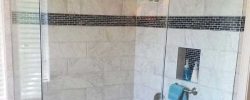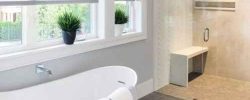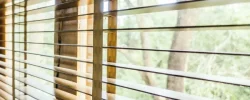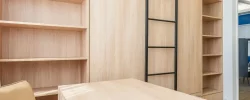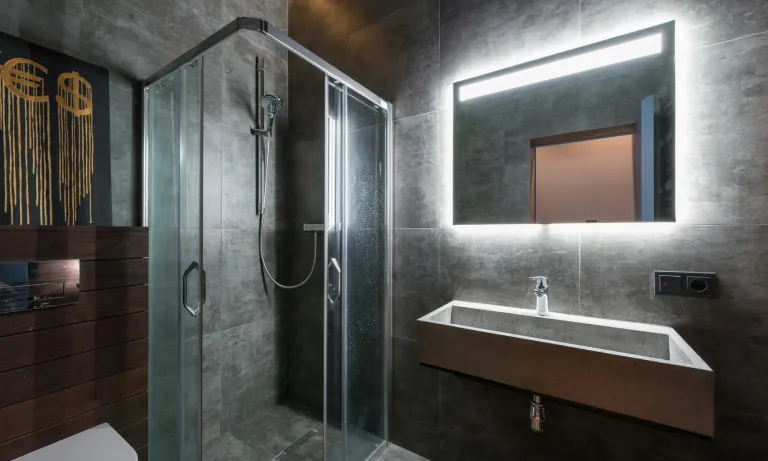The humble shower door, a once overlooked feature in bathroom design, has undergone a remarkable evolution, becoming a central element in modern bathroom aesthetics and functionality. This evolution mirrors broader trends in interior design, where practical elements are transformed into focal points that enhance both the beauty and usability of a space.
Historical Overview
The journey of shower doors began with simple, functional designs aimed primarily at privacy and water containment. In the early days, shower curtains were the norm, but they were soon replaced by glass doors in many homes for their durability and ease of cleaning. The 1950s and 1960s saw the rise of framed glass doors, which were heavy, often featured opaque or frosted glass, and were mounted in metal frames to ensure stability.
Design Transformation in the Late 20th Century
As interior design trends evolved, so did shower doors. In the 1970s and 1980s, homeowners began to prefer lighter, more aesthetically pleasing designs. This led to the development of thinner, tempered glass doors that were safer and more elegant. The 1990s introduced more diversity in design, with etched and patterned glass options allowing for personalization.
The 21st Century: A Focus on Minimalism and Transparency
The turn of the century marked a significant shift towards minimalism and clean lines in interior design, influencing shower door styles. Frameless shower doors became increasingly popular, offering a sleek, uninterrupted look that maximized the sense of space in the bathroom. This style uses heavy-duty glass that doesn’t need the support of a frame and is held in place with discrete hinges and handles, creating an open and airy feel.
Technological Advancements and Innovative Materials
Advancements in technology have also played a crucial role in the evolution of shower doors. Manufacturers began experimenting with different types of glass and treatments to enhance functionality and aesthetics. For example, the development of low-iron glass offered unparalleled clarity, making the glass almost invisible. Additionally, treatments such as hydrophobic coatings were introduced, which repel water and reduce spotting and staining, thereby reducing cleaning time and increasing the lifespan of the glass.
Smart Glass: A Leap into the Future
One of the most exciting developments in recent years is the advent of smart glass. This technology allows glass to change from transparent to opaque at the flick of a switch, offering instant privacy without the need for curtains or blinds. This innovation is not only a leap in functionality but also opens new avenues in bathroom design, allowing for the creation of dynamic spaces that can be transformed according to need.
Sustainability and Eco-Friendly Designs
In line with global trends towards sustainability, the shower door industry has also adapted, with eco-friendly designs becoming increasingly popular. Recyclable materials, energy-efficient manufacturing processes, and doors that improve natural heating and lighting in bathrooms are all part of this green shift.
Customization and Personalization
Today, customization is key in shower door design. Homeowners and designers now have a plethora of options, from bespoke sizes and shapes to a range of finishes and colors for hardware. This level of customization ensures that shower doors can perfectly complement any bathroom design, from classic to contemporary.
Current and Emerging Trends
The latest trends in shower door design reflect a blend of functionality, aesthetic appeal, and technological innovation. Black framed shower doors are making a comeback, offering a bold, graphic look that contrasts beautifully with both bright and muted tile colors. Sliding barn-door style doors are also gaining popularity for their space-saving functionality and rustic appeal.
Looking to the future, we can expect to see continued innovation in materials and technology. The integration of smart home technology with shower doors, such as doors that can monitor water usage or temperature, is not far from reality. Additionally, the exploration of different materials, such as lightweight composites that offer the same transparency as glass but with greater durability, could revolutionize shower door design.
The evolution of shower doors is a testament to the ever-changing landscape of interior design and technology. From their humble beginnings as purely functional elements, they have transformed into key components of bathroom design, influencing the aesthetics and feel of the space. As we look forward, it is clear that this evolution will continue, with innovations in technology, materials, and design pushing the boundaries of what is possible, making shower doors an exciting and dynamic element of home design.






